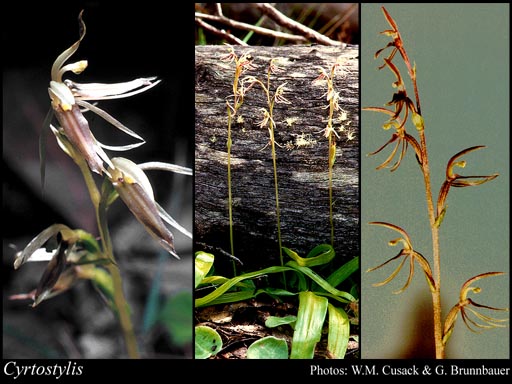- Reference
- Prodr.Fl.Nov.Holland. 322 (1810)
- Name Status
- Current

Scientific Description
Family Orchidaceae.
Habit and leaf form. Herbs. Leaves well developed, or much reduced, or absent. Plants succulent, or non-succulent. Perennial. Leaves basal. Tuberous. Helophytic, or mesophytic, or xerophytic. Leaves small to medium-sized; ‘herbaceous’, or leathery, or fleshy; sessile; simple. Leaf blades entire; flat; parallel-veined; cross-venulate, or without cross-venules; cordate. Leaf blade margins entire. Stem anatomy. Secondary thickening absent.
Reproductive type, pollination. Fertile flowers hermaphrodite. Unisexual flowers absent. Plants hermaphrodite. Floral nectaries present. Nectar secretion from the perianth (produced in a tiny well at the base of the labellum). Entomophilous. Pollination mechanism conspicuously specialized (the nectar runs down the labellum along a central groove, enticing pollinators such as small flies, gnats and mosquitoes).
Inflorescence and flower features. Flowers solitary, or aggregated in ‘inflorescences’. Inflorescence few-flowered. Flowers in racemes (loose). The terminal inflorescence unit racemose. Inflorescences scapiflorous, or not scapiflorous; terminal. Flowers small to medium-sized; fragrant, or odourless; very irregular; zygomorphic; resupinate. The floral asymmetry involving the perianth and involving the androecium. Flowers 3 merous; cyclic; supposedly basically pentacyclic. Perigone tube absent. Perianth of ‘tepals’, or with distinct calyx and corolla; 6; 2 -whorled; isomerous (but zygomorphic); free. Calyx (if the outer whorl be so designated) 3 (the median member ostensibly posterior); 1 -whorled; polysepalous. Corolla (i.e. the members of the inner whorl) 3; polypetalous; imbricate. Androecium 3, or 1 (by misinterpretation). Androecial members free of the perianth; united with the gynoecium (fused with the style to form a column or ‘gynostemium’; column abruptly incurved, terminating in a knob-like anther); coherent (via the gynostemium); 1 - adelphous; theoretically 2 -whorled. Androecium including staminodes, or exclusively of fertile stamens (by misinterpretation). Staminodes 2 (these anterior (ostensibly posterior), supposedly the abaxial pair of the inner whorl). Stamens 1 (this across the flower from the labellum, i.e. anterior but ostensibly posterior, supposedly representing the outer whorl); reduced in number relative to the adjacent perianth; alterniperianthial (i.e. with reference to the single stamen, across the flower from the labellum); filantherous, or with sessile anthers. Anthers dorsifixed to basifixed; dehiscing via longitudinal slits; introrse; tetrasporangiate; appendaged, or unappendaged. Pollen shed in aggregates; in the form of pollinia (pollinia 4, plus viscid material, viscidium absent). Gynoecium 3 carpelled. The pistil 1 celled. Carpels isomerous with the perianth. Gynoecium syncarpous; eu-syncarpous; inferior. Ovary unilocular; 1 locular. The ‘odd’ carpel anterior (away from the labellum). Gynoecium stylate. Styles 1 (inflexed); apical. Stigmas 1; 3 - lobed (but becoming much modified in form, the apex of the median lobe forming the ‘rostellum’); wet type; papillate; Group III type. Placentation parietal. Ovules not differentiated; in the single cavity 30–100 (i.e. very numerous); non-arillate; anatropous.
Fruit and seed features. Fruit non-fleshy; dehiscent; a capsule. Capsules septicidal, or loculicidal. Fruit 30–500 seeded (i.e. seeds usually very numerous). Seeds endospermic (endosperm development arrested very early), or non-endospermic; minute; without starch. Embryo rudimentary at the time of seed release, or weakly differentiated. Seedling. Seedling collar not conspicuous. Primary root ephemeral.
Geography, cytology, number of species. Native of Australia. Endemic to Australia. Australian states and territories: Western Australia. South-West Botanical Province.
Additional characters Perianth of 5 similar members and the median inner member modified into the labellum (sepals and lateral petals of similar length, narrow, tips non-glandular; labellum more or less oblong, flat, basal glands erect, conical, with a flat central plate on lamina, surface smooth). Leaves solitary. Column prominently winged. Labellum not motile. Perianth not glossy.